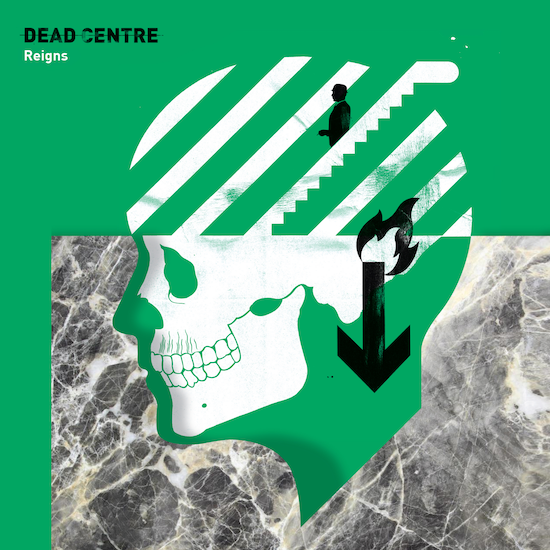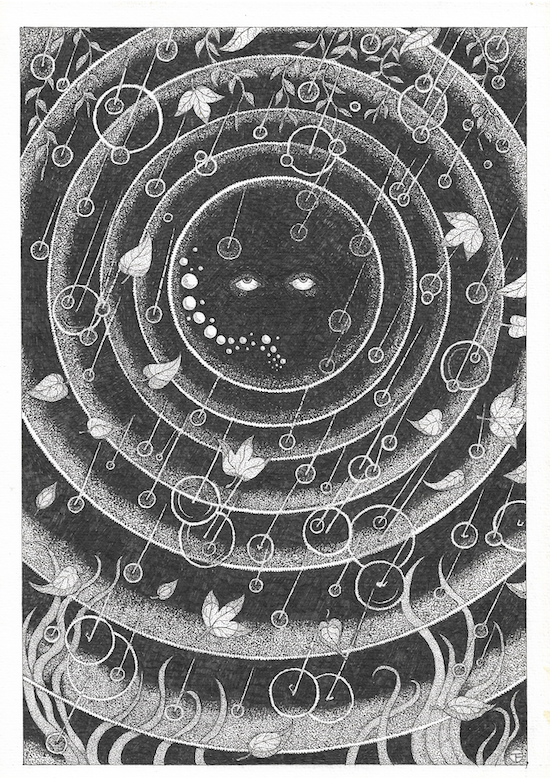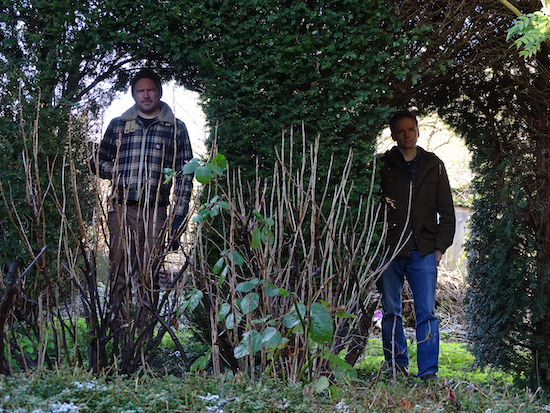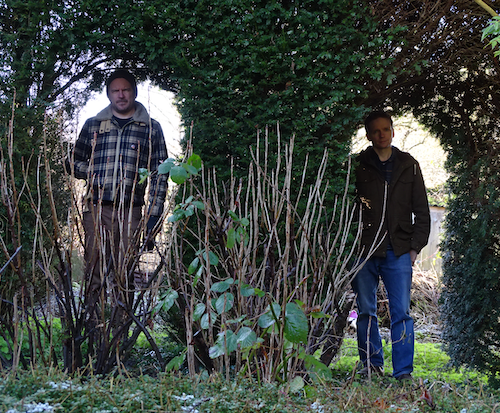To receive Dead Centre by Reigns, become a Quietus Sound And Vision subscriber
“The skin of the globe contracted, the nozzle twitched, and something was expelled with a dry wheeze. A coin? A pebble? Something so tiny as to be invisible. But whatever insignificant debris had been evacuated, the masses went wild trying to claim it, clambering, grasping, fighting, as if it were the Holy Grail itself.”
Tim Farthing – Dead Centre (2024)
Creative collaborators from early childhood, brothers Tim and Roo Farthing began recording as Reigns in 2004. Embodying a concern with the supernatural and folklore of their native Somerset, and fuelled by an interest in film soundtracks and imaginative literary conceits, Reigns’ first album was about a bottomless hole, while the second concerned a submerged village. Later releases like Tollinghurst concerned a fictional English commercial artist, ‘Edith Tollinghurst’, and the tarot deck she supposedly created. “With each album, we pretend that it’s real folklore,” says Tim Farthing. “We had people emailing us saying ‘I’ve Googled Edith Tollinghurst and I can’t find anything.’”
Adds Roo: “It’s also about making music where there are just the two of us in a room. It’s quite a different thing from being in a band, where I guess you have to make decisions quite quickly.” The two also play guitar and drums respectively for Hey Colossus, where “everything happens quickly and you’re generally stuck with your first take for the rest of time, whereas with this recording, we started in June 2022 and chipped away at it over the course of about a year. It’s sort of like whittling, you gradually get it in the kind of shape you want and you work out how all of the bits segue into each other. We don’t have to say a great deal when we’re doing it, it just sort of happens. To have that as a balance against being in a room with other people making a racket, to do something really considered, is fun.”
Early on, the duo say, they took a more folky approach, inspired by Steve Reich and an obsession with Stewart Copeland’s Rumblefish soundtrack. “We were watching John Carpenter films,” adds Roo. “The Fog and Escape From New York. That kind of dark electronic thing has always been a part of what we do, and [we were] fusing that with acoustic instruments early on.” Tim also expresses a love of Ennio Morricone’s Exorcist II: The Heretic soundtrack, whilst Roo cites John Williams and Bernard Hermann’s more traditional movie scores too.
Another favourite was the Angel Heart soundtrack. “Those were the days when they used to put the dialogue into the music, which they don’t tend to do so much nowadays,” says Tim. “With Reigns you can hear it all the time, where we’re sticking voices into the music. A lot of that comes from Angel Heart.” More recently, Zarelli’s album featuring Leonard Nimoy reading Ray Bradbury, Soft Rains, appealed to the brothers too. “Just having that mixture of a really great narrative and a familiar voice from your youth with that electronic score was something that we really loved”, Roo says.
The ambience the duo deploy in their music is less about keyboard presets and more about an openness to capturing subtle elements of their surroundings, and leaving a door slightly open to chance occurrence. Explains Roo: “We’ve got a sort of attic room in my house. It’s all done with a laptop and we’ve got some pretty ancient keyboards, a couple of microphones. It’s pretty basic. There’s no sound insulation, so if you’re recording an acoustic guitar and there are birds on the roof jumping around making a racket, generally we tend to leave that sort of thing in.”
For their seventh record Dead Centre, available exclusively for Quietus Sound + Vision subscribers, which is also intended as accompaniment to the book of the same name out on fellow Colossus Joe Thompson’s Wrong Speed label in April, the pair created a 40 minute track, attempting to follow the basic narrative flow of the book for the duration. “It does structurally fit the book, but we had to leave room to make the album stand up by itself,” says Tim. They managed just that, with the piece acting like a hypnotic inducement to a sinister, yet beguiling movie that unfurls before the mind’s eye. Textures shift throughout its course, ambient washes leading into beat-driven sections, eerie Suspiria-like keyboard melodies, and a briefly folky passage that recalls Reigns’ earlier sound.

The book concerns a sick and homeless protagonist, Kemp, whose pilgrimage to see his estranged daughter ends in a botched suicide attempt and accidental imprisonment inside a shopping centre that’s been shut down for the holidays. There, he comes to notice that something is awry – a strange waterway cutting through the centre, shadowy forms that gather at night, and a mysterious tunnel that only opens after closing time – and it slowly dawns on him that “the sins of his past and a life spent on the margins have uniquely qualified him for a job he never asked for: ferryman to the dead,” as an official synopsis puts it.
“The whole book revolves around a central absence, which I think we feel about public life and especially politics. It just seems to be that there’s no one at the controls,” Tim continues. “I think more terrifying than the concept of hell is that Kemp gets there and they’ve all fucked off. It’s been abandoned. I do feel that everyone, possibly, feels as though they’ve been abandoned. The book is structured so the chapters go from one to twelve and there’s a big black hole in the middle, which is the only chapter that isn’t in the same location. It counts down from 12 to nothing, so that the middle is a black hole where we hear about his past and his crime. We tried to do that with the music, so that the exact centre of the 40 minutes has a sort of howling void at the middle of it all.”
The book is a compelling read, staking out similar territory to other such ‘afterlife’ novels as Flann O’Brien’s The Third Policeman or Alan Moore’s Jerusalem, but with some unique twists of its own. Tim Farthing’s prose is expressive but accessible, and the notion of making a homeless man on the verge of death the antihero of the piece seems both timely and original. “I was thinking initially of JG Ballard’s 70s novels,” he says. “Of a character being stuck in a location, like Concrete Island or Unlimited Dream Company. I wrote a novel before this one and it was very long winded, had millions of characters and locations and timelines. I thought, this time I’m going to keep it simple and go from A to Z. It didn’t quite turn out that way but that was the intention. I wanted someone who was at the bottom of the ladder as a hero. I thought that might be interesting. It was a juxtaposition of him having nothing and suddenly having anything that he wanted. I thought that might be quite a good contrast.”
Not content to ‘only’ write a book with its own accompanying soundtrack, Dead Centre also contains a series of stylish illustrations in pen and ink. Tim disarmingly jokes that he’s a “jack of all trades, master of none”. The music itself took about “a year of Sundays,” he says. “We thought it would be something we could snap off in a month but we kept getting sucked deeper and deeper into it. Total black hole.”

Such an impressive debut novel naturally begs the question – will there be more to come? “I’m always beavering away in the background,” Tim says. “Though whether it will ever see the light of day I don’t know. I’ve got a preposterously long novel about Satan that I might come back to. I’m not sure. It could be a colossal folly but, it’s like a dog going back to its own sick…”
He adds that he thinks “the next Reigns album will be more song-based, as we haven’t really tried that before. Maybe it will be our first album without a concept?” For the time being, Quietus subscribers and future readers of Dead Centre have something of an adventure ahead of them, into the underworld and beyond the void at the heart of consumer culture.
To receive Dead Centre by Reigns, as well as a host of other benefits including exclusive essays, podcasts and playlists, and loads more specially-commissioned music, become a Quietus Sound And Vision subscriber. You can do so here



